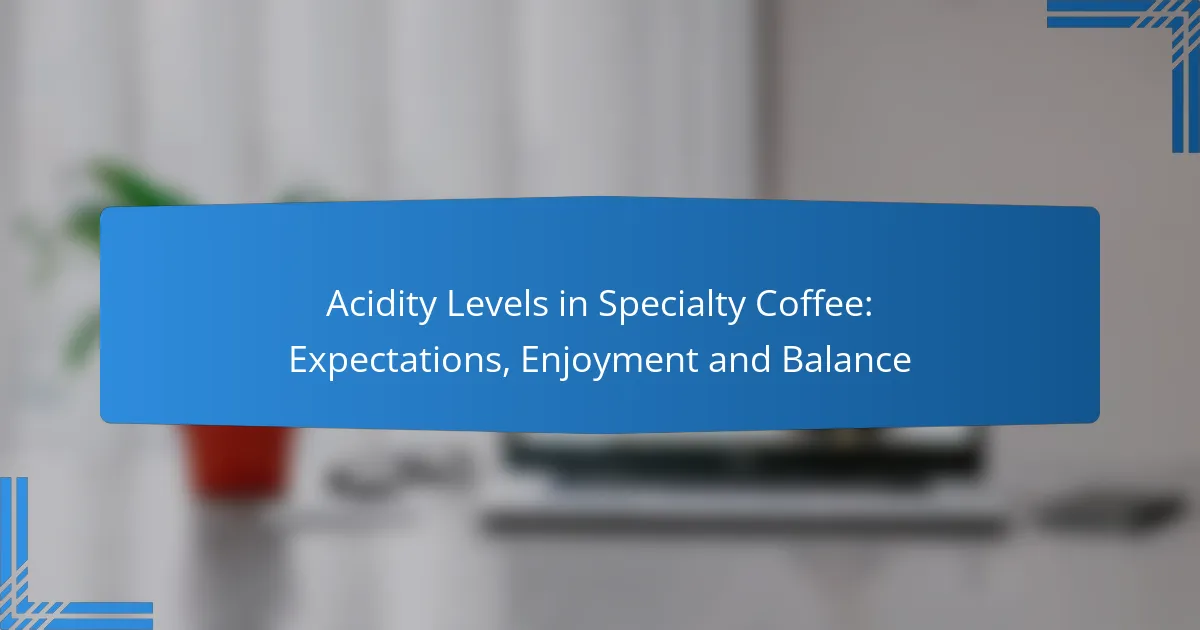Acidity levels are essential to the enjoyment of specialty coffee, shaping its flavor, mouthfeel, and aftertaste. A well-balanced acidity enhances the coffee experience, while imbalances can detract from it. Understanding how different roast types affect acidity and adjusting brewing parameters can help you achieve the perfect cup.

How Do Acidity Levels Affect Specialty Coffee Enjoyment?
Acidity levels play a crucial role in the enjoyment of specialty coffee by influencing its overall flavor, mouthfeel, and aftertaste. A well-balanced acidity can enhance the coffee experience, while excessive or insufficient acidity may detract from it.
Influence on flavor profile
Acidity contributes significantly to the flavor profile of specialty coffee, often adding brightness and complexity. Coffees with higher acidity, such as those from East Africa, tend to exhibit fruity and floral notes, while lower acidity coffees, like those from Brazil, may present more chocolatey or nutty flavors.
When selecting coffee, consider the origin and processing method, as these factors can greatly influence acidity. For example, washed coffees typically have a cleaner taste with pronounced acidity, whereas natural processed coffees may have a more subdued acidity with richer flavors.
Impact on mouthfeel
The mouthfeel of coffee is affected by its acidity, which can create a sensation of liveliness on the palate. Higher acidity often results in a lighter, crisper mouthfeel, while lower acidity can lead to a heavier, smoother experience.
When tasting coffee, pay attention to how the acidity interacts with other elements like sweetness and bitterness. A balanced coffee will have a pleasant mouthfeel that complements its flavor profile, enhancing overall enjoyment.
Role in aftertaste
Acidity also plays a vital role in the aftertaste of specialty coffee, influencing how flavors linger after swallowing. A coffee with bright acidity may leave a clean, refreshing finish, while one with low acidity might have a more muted aftertaste.
To evaluate aftertaste, sip the coffee and note how long the flavors persist. A desirable aftertaste should be pleasant and harmonious, reinforcing the coffee’s overall character without overwhelming it. Look for coffees that maintain a balance between acidity and other flavor components for a satisfying finish.

What Are the Ideal Acidity Levels for Different Coffee Types?
The ideal acidity levels in coffee vary significantly by type, influencing flavor and overall enjoyment. Generally, lighter roasts exhibit higher acidity, while darker roasts tend to have lower acidity, impacting the coffee’s taste profile.
Light roasts
Light roasts typically have a bright acidity, often described as fruity or floral. This acidity can range from medium to high, contributing to a vibrant and complex flavor profile. Common examples include coffees from regions like Ethiopia and Kenya, where the natural characteristics shine through.
When selecting light roasts, look for tasting notes that highlight citrus or berry flavors, which often indicate higher acidity. Enjoy these coffees brewed using methods like pour-over or Aeropress to accentuate their brightness.
Medium roasts
Medium roasts strike a balance between acidity and body, offering a moderate acidity level that enhances sweetness and complexity. The acidity in these coffees is generally lower than in light roasts but still noticeable, making them versatile for various brewing methods.
Popular medium roasts often come from Central America, such as Guatemala or Costa Rica. These coffees typically feature notes of caramel or chocolate, appealing to those who enjoy a smoother cup without sacrificing flavor.
Dark roasts
Dark roasts have the lowest acidity levels, resulting in a bold and rich flavor profile. The roasting process reduces acidity, often leading to a taste characterized by deep, smoky, or chocolatey notes. Common origins for dark roasts include Brazil and Sumatra.
When brewing dark roasts, consider methods like French press or espresso to highlight their full-bodied characteristics. While these coffees may lack brightness, their robust flavors can be very satisfying for those who prefer a less acidic cup.

How Can You Balance Acidity in Coffee Brewing?
Balancing acidity in coffee brewing involves adjusting various factors such as water temperature, brewing time, and grind size. Each of these elements can significantly influence the final flavor profile, allowing you to achieve a more enjoyable cup.
Water temperature adjustments
Water temperature plays a crucial role in extracting flavors from coffee grounds. Generally, a temperature range of 90-96°C (194-205°F) is recommended for brewing specialty coffee. Lower temperatures tend to yield a smoother, less acidic cup, while higher temperatures can enhance acidity and brightness.
To balance acidity, experiment with slightly cooler water for a sweeter taste or hotter water for a more vibrant flavor. Avoid boiling water, as it can scorch the coffee and create undesirable bitterness.
Brewing time modifications
Brewing time directly affects the extraction of acids and other compounds from coffee. Shorter brewing times, typically around 2-4 minutes for methods like pour-over, can result in a cleaner, less acidic cup. Conversely, longer brewing times may extract more acidity and bitterness.
To find the right balance, start with a standard brewing time and adjust in small increments. If your coffee tastes too acidic, try reducing the brewing time slightly to see if it improves the flavor.
Grind size considerations
The grind size of your coffee beans influences the extraction rate and, consequently, the acidity level. Finer grinds increase surface area, leading to quicker extraction and potentially higher acidity, while coarser grinds slow down extraction, resulting in a smoother flavor.
For a balanced cup, aim for a medium grind for most brewing methods. If your coffee is overly acidic, consider using a coarser grind to reduce extraction speed and acidity. Adjusting grind size is a simple yet effective way to refine your brewing results.

What Tools Help Measure Acidity in Coffee?
Measuring acidity in coffee is essential for understanding its flavor profile and ensuring balance. Several tools are available to help coffee enthusiasts and professionals accurately assess acidity levels, each with its own advantages and considerations.
pH meters
pH meters are electronic devices that provide precise measurements of acidity levels in coffee. They work by measuring the voltage difference between two electrodes immersed in the coffee solution, which correlates to the pH level. A typical pH range for coffee is around 4.5 to 6, with lower values indicating higher acidity.
When using a pH meter, ensure it is calibrated regularly for accurate readings. Avoid exposing the electrodes to extreme temperatures or contaminants, as this can affect performance. For best results, measure the coffee at room temperature.
Acidity test strips
Acidity test strips are simple, cost-effective tools that provide a quick way to gauge the acidity of coffee. These strips change color based on the pH level of the liquid they come into contact with, allowing for a visual assessment. They are generally less precise than pH meters but can be useful for casual testing.
To use acidity test strips, immerse the strip in the coffee for a few seconds, then compare the resulting color to the provided scale. Keep in mind that environmental factors, such as light and temperature, can influence the accuracy of the color reading.
Specialty coffee refractometers
Specialty coffee refractometers measure the refractive index of coffee, which correlates with its soluble solids and acidity. This tool is particularly useful for coffee professionals looking to analyze brew strength and flavor balance. A refractometer can provide insights into how acidity contributes to the overall taste experience.
When using a refractometer, place a few drops of coffee on the prism and close the cover. Look through the eyepiece to read the measurement. Regular calibration is essential to ensure accuracy, and it’s best to use the tool with freshly brewed coffee for optimal results.

What Are the Health Implications of Coffee Acidity?
Coffee acidity can affect health in various ways, particularly for individuals with sensitive stomachs or dental concerns. Understanding these implications can help coffee drinkers make informed choices about their consumption.
Effects on stomach sensitivity
Coffee acidity can irritate the stomach lining, leading to discomfort or exacerbating conditions like acid reflux and gastritis. Those with sensitive stomachs may experience symptoms such as heartburn or indigestion after consuming highly acidic coffee.
To mitigate these effects, consider opting for low-acid coffee varieties or brewing methods that reduce acidity, such as cold brew. Drinking coffee with food can also help buffer acidity and lessen potential irritation.
Impact on dental health
The acidity in coffee can contribute to enamel erosion, increasing the risk of cavities and tooth sensitivity. Regular consumption of highly acidic beverages can lead to a gradual weakening of tooth enamel over time.
To protect dental health, it’s advisable to rinse the mouth with water after drinking coffee and maintain good oral hygiene. Using a straw can also help minimize contact between acidic coffee and teeth.
